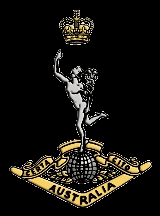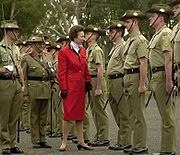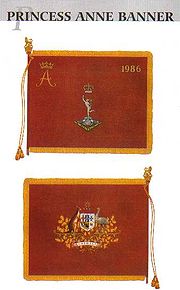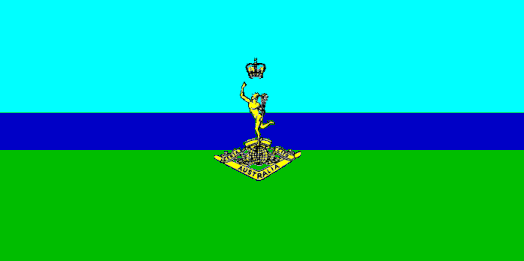
Royal Australian Corps of Signals
Encyclopedia
The Royal Australian Corps of Signals (RASigs) is one of the 'arms' (combat support corps) of the Australian Army
. It is responsible for installing, maintaining and operating all types of telecommunications equipment and information systems. The motto of the Signals Corps is Certa Cito and is translated as 'Swift and Sure', signifying the aim of the signal service - that communication be carried out with maximum speed and certainty. Like their British counterparts
, the Royal Australian Corps of Signals' flag and hat badge feature Mercury
, the winged messenger of the gods, affectionately referred to by members of the corps as "Jimmy" (the origin dates back to the merge with Engineers when the Engineer's band's Drum Major had a "Jimmy" on his staff).
Modern Army command and control
systems demand reliable, high speed transfer of large volumes of data. The communications systems provided by Signals must keep pace with modern information technology
. The control of the electromagnetic spectrum
offers a decisive advantage in modern warfare and Electronic Warfare
, listening to or interfering with enemy electronic transmissions, is a critical contribution by the Signals Corps to the Army's combat capability.
On the battlefield Signals provides commanders with the means of controlling the battle using road and air dispatch services, radio, microwave and satellite links. A high technology computer switched digital network, capable of providing a high quality, high capacity, secure communications network is being introduced.
The Corps has recently taken over the responsibility for Army Information Systems. Signal Corps personnel now control large integrated information systems and are responsible for the installation and operation of local area network
s using state-of-the art computer equipment.
Specialist roles in the Corps include:
Communication System Operator (Known in the Corps as "Operators"),
Telecommunications Technician (Known as "Techs" or "Techies"),
Electronic Warfare Operator (Known as "Bears" from being primarily posted to a base near Cabarlah (Koala), QLD") and
Information Systems Technician (Known as "Geeks").


 Australia has the unique distinction of having had the first regularly formed signal unit in the British Empire
Australia has the unique distinction of having had the first regularly formed signal unit in the British Empire
. The Corps began in 1869 as a small "torpedo and signals corp", located in New South Wales
and Victoria
. These units existed until 1882, when they were disbanded. In 1885, a "signalling corps", composed of one officer and twelve other ranks, was created in South Australia
and remained active until 1901.
After the inception of the Commonwealth Forces, an "Australian Corps of Signallers" was formed on 12 January 1906. This day is recognised as the Signal Corps' birthday. The Corps remained as a self contained unit until 1911 when it was merged with Australian Engineers.
On 1 January 1925, the Australian Corps of Signals was formed and all Signals units were separated from the Australian Corps of Engineers.
At the conclusion of World War II
, a silver salver was presented to the Australian Corps of Signals by Princess Mary as a memento of the co-operation between the Royal Corps of Signals
and the Australian Corps of Signals throughout the Second World War.
On 10 November 1948, His Majesty King George VI
conferred the title "Royal" on the Australian Corps of Signals. The day is recognised a "Corps Day", and commemorative functions are held on, or as near as possible to, 10 November each year.
Approval was given by Her Royal Highness, Princess Anne
, The Princess Royal
, the Signals Corps' Colonel-in-Chief
, on 10 September 1980 for the Corps to carry a banner bearing her Cipher. The banner is known as "The Princess Anne Banner", and was presented to the Signals Corps by the then Governor-General
, The Right Honourable Sir Ninian Stephen
on 29 November 1986.
On 5 July 2000, a parade was held for her Royal Highness, Princess Anne, The Princess Royal at Simpson Barracks
, Watsonia
, marking the 75th anniversary of the Corps.
and Army Reserve
. Each brigade of the Army has a Signals Squadron which forms part of the brigade's Command Support Regiment. The Army's two divisions each has a signal regiment.

 The Royal Australian Corps of Signals has two sets of colours, tactical and domestic. The Tactical colours are White on Royal blue. White symbolises the ribbons wound on the Caduceus
The Royal Australian Corps of Signals has two sets of colours, tactical and domestic. The Tactical colours are White on Royal blue. White symbolises the ribbons wound on the Caduceus
of the God Hermes
and the Blue representing the Royal Colours. The domestic colours, sky blue on dark blue on dark green, represent the three mediums of communication: air, sea and land.
. The School of Signals is a tri-service educational facility located on Simpson Barracks
in Watsonia, Victoria
. It is the home of the Signals Corps and the centre for defence training in communications and information systems for the Australian Defence Force. The school was previously located at Balcombe, before moving to Watsonia in the late 1960s. though Balcombe was maintained as a training location for some Signals and Army apprentice courses into the 1980s. The School also has an Electronic Warfare wing, called the Joint Telecommunications School, located on Borneo Barracks in Cabarlah, Queensland.
Regardless of specialisation, all soldiers joining the Signals Corps (On successful completion of the 80 Day Recruit Course held in Kapooka) first complete an eight day Common Corps course which provides basic Royal Australian Corps of Signals skills in radio, line laying and computing and is a prerequisite for all Australian Regular Army RA Sigs trade courses. The course (and most subsequent training) is held at Defence Force School of Signals, Simpson Barracks Macleod, Victoria. On successful completion of the Common Corps course, students will be placed in a holding platoon while they wait for their trade course to start. During this time students may be placed on other courses, such as driver training.
 Parakeet was the project name used by the Australian Army's mobile BTN (Battlefield Telecommunications Network). It was introduced into service in the mid 1990s through project JP65. At the time of its introduction, Project Parakeet was considered to be a highly advanced military communications
Parakeet was the project name used by the Australian Army's mobile BTN (Battlefield Telecommunications Network). It was introduced into service in the mid 1990s through project JP65. At the time of its introduction, Project Parakeet was considered to be a highly advanced military communications
system. It included secure voice
and data trunking
services. In 2002, the Defence Force raised Project JP2072 to upgrade its sub-systems. Today, years after its introduction, it is still incorrectly referred to as Parakeet. The Parakeet suite of equipment is operated by members of the Operator Bearer Systems and Technician trade.
Australian Army
The Australian Army is Australia's military land force. It is part of the Australian Defence Force along with the Royal Australian Navy and the Royal Australian Air Force. While the Chief of Defence commands the Australian Defence Force , the Army is commanded by the Chief of Army...
. It is responsible for installing, maintaining and operating all types of telecommunications equipment and information systems. The motto of the Signals Corps is Certa Cito and is translated as 'Swift and Sure', signifying the aim of the signal service - that communication be carried out with maximum speed and certainty. Like their British counterparts
Royal Corps of Signals
The Royal Corps of Signals is one of the combat support arms of the British Army...
, the Royal Australian Corps of Signals' flag and hat badge feature Mercury
Mercury (mythology)
Mercury was a messenger who wore winged sandals, and a god of trade, the son of Maia Maiestas and Jupiter in Roman mythology. His name is related to the Latin word merx , mercari , and merces...
, the winged messenger of the gods, affectionately referred to by members of the corps as "Jimmy" (the origin dates back to the merge with Engineers when the Engineer's band's Drum Major had a "Jimmy" on his staff).
Modern Army command and control
Command and Control (military)
Command and control, or C2, in a military organization can be defined as the exercise of authority and direction by a properly designated commanding officer over assigned and attached forces in the accomplishment of the mission...
systems demand reliable, high speed transfer of large volumes of data. The communications systems provided by Signals must keep pace with modern information technology
Information technology
Information technology is the acquisition, processing, storage and dissemination of vocal, pictorial, textual and numerical information by a microelectronics-based combination of computing and telecommunications...
. The control of the electromagnetic spectrum
Electromagnetic spectrum
The electromagnetic spectrum is the range of all possible frequencies of electromagnetic radiation. The "electromagnetic spectrum" of an object is the characteristic distribution of electromagnetic radiation emitted or absorbed by that particular object....
offers a decisive advantage in modern warfare and Electronic Warfare
Electronic warfare
Electronic warfare refers to any action involving the use of the electromagnetic spectrum or directed energy to control the spectrum, attack an enemy, or impede enemy assaults via the spectrum. The purpose of electronic warfare is to deny the opponent the advantage of, and ensure friendly...
, listening to or interfering with enemy electronic transmissions, is a critical contribution by the Signals Corps to the Army's combat capability.
On the battlefield Signals provides commanders with the means of controlling the battle using road and air dispatch services, radio, microwave and satellite links. A high technology computer switched digital network, capable of providing a high quality, high capacity, secure communications network is being introduced.
The Corps has recently taken over the responsibility for Army Information Systems. Signal Corps personnel now control large integrated information systems and are responsible for the installation and operation of local area network
Local area network
A local area network is a computer network that interconnects computers in a limited area such as a home, school, computer laboratory, or office building...
s using state-of-the art computer equipment.
Specialist roles in the Corps include:
Communication System Operator (Known in the Corps as "Operators"),
Telecommunications Technician (Known as "Techs" or "Techies"),
Electronic Warfare Operator (Known as "Bears" from being primarily posted to a base near Cabarlah (Koala), QLD") and
Information Systems Technician (Known as "Geeks").
History



British Empire
The British Empire comprised the dominions, colonies, protectorates, mandates and other territories ruled or administered by the United Kingdom. It originated with the overseas colonies and trading posts established by England in the late 16th and early 17th centuries. At its height, it was the...
. The Corps began in 1869 as a small "torpedo and signals corp", located in New South Wales
New South Wales
New South Wales is a state of :Australia, located in the east of the country. It is bordered by Queensland, Victoria and South Australia to the north, south and west respectively. To the east, the state is bordered by the Tasman Sea, which forms part of the Pacific Ocean. New South Wales...
and Victoria
Victoria (Australia)
Victoria is the second most populous state in Australia. Geographically the smallest mainland state, Victoria is bordered by New South Wales, South Australia, and Tasmania on Boundary Islet to the north, west and south respectively....
. These units existed until 1882, when they were disbanded. In 1885, a "signalling corps", composed of one officer and twelve other ranks, was created in South Australia
South Australia
South Australia is a state of Australia in the southern central part of the country. It covers some of the most arid parts of the continent; with a total land area of , it is the fourth largest of Australia's six states and two territories.South Australia shares borders with all of the mainland...
and remained active until 1901.
After the inception of the Commonwealth Forces, an "Australian Corps of Signallers" was formed on 12 January 1906. This day is recognised as the Signal Corps' birthday. The Corps remained as a self contained unit until 1911 when it was merged with Australian Engineers.
On 1 January 1925, the Australian Corps of Signals was formed and all Signals units were separated from the Australian Corps of Engineers.
At the conclusion of World War II
World War II
World War II, or the Second World War , was a global conflict lasting from 1939 to 1945, involving most of the world's nations—including all of the great powers—eventually forming two opposing military alliances: the Allies and the Axis...
, a silver salver was presented to the Australian Corps of Signals by Princess Mary as a memento of the co-operation between the Royal Corps of Signals
Royal Corps of Signals
The Royal Corps of Signals is one of the combat support arms of the British Army...
and the Australian Corps of Signals throughout the Second World War.
On 10 November 1948, His Majesty King George VI
George VI of the United Kingdom
George VI was King of the United Kingdom and the Dominions of the British Commonwealth from 11 December 1936 until his death...
conferred the title "Royal" on the Australian Corps of Signals. The day is recognised a "Corps Day", and commemorative functions are held on, or as near as possible to, 10 November each year.
Approval was given by Her Royal Highness, Princess Anne
Anne, Princess Royal
Princess Anne, Princess Royal , is the only daughter of Elizabeth II and Prince Philip, Duke of Edinburgh...
, The Princess Royal
Princess Royal
Princess Royal is a style customarily awarded by a British monarch to his or her eldest daughter. The style is held for life, so a princess cannot be given the style during the lifetime of another Princess Royal...
, the Signals Corps' Colonel-in-Chief
Colonel-in-Chief
In the various Commonwealth armies, the Colonel-in-Chief of a regiment is its patron. This position is distinct from that of Colonel of the Regiment. They do not have an operational role. They are however kept informed of all important activities of the regiment, and pay occasional visits to its...
, on 10 September 1980 for the Corps to carry a banner bearing her Cipher. The banner is known as "The Princess Anne Banner", and was presented to the Signals Corps by the then Governor-General
Governor-General
A Governor-General, is a vice-regal person of a monarch in an independent realm or a major colonial circonscription. Depending on the political arrangement of the territory, a Governor General can be a governor of high rank, or a principal governor ranking above "ordinary" governors.- Current uses...
, The Right Honourable Sir Ninian Stephen
Ninian Stephen
Sir Ninian Martin Stephen, is a retired politician and judge, who served as the 20th Governor-General of Australia and as a Justice in the High Court of Australia.-Early life:...
on 29 November 1986.
On 5 July 2000, a parade was held for her Royal Highness, Princess Anne, The Princess Royal at Simpson Barracks
Simpson Barracks
Simpson Barracks is an Australian Army facility in the suburb of Macleod in Melbourne, Victoria, Australia.Simpson Barracks is home to the DFSS , Financial Services Unit, Defence Force School of Music, Land Warfare Centre and the headquarters of 4th Brigade...
, Watsonia
Watsonia, Victoria
Watsonia is a suburb in Melbourne, Victoria, Australia, 16 km north-east from Melbourne's central business district. Its Local Government Area is the City of Banyule. At the 2006 Census, Watsonia had a population of 4905.-History:...
, marking the 75th anniversary of the Corps.
Structure
The Royal Australian Signals Corps is divided into a number of regiments and squadrons, both Regular ArmyAustralian Army
The Australian Army is Australia's military land force. It is part of the Australian Defence Force along with the Royal Australian Navy and the Royal Australian Air Force. While the Chief of Defence commands the Australian Defence Force , the Army is commanded by the Chief of Army...
and Army Reserve
Australian Army Reserve
The Australian Army Reserve is a collective name given to the reserve units of the Australian Army. Since the Federation of Australia in 1901, the reserve military force has been known by many names, including the Citizens Forces, the Citizen Military Forces, the Militia and, unofficially, the...
. Each brigade of the Army has a Signals Squadron which forms part of the brigade's Command Support Regiment. The Army's two divisions each has a signal regiment.
Regular Army
- Regiments
- 1 Signal Regiment (DJFHQ/1 Division) (formerly 1 Joint Support Unit)
- 101 Signal Squadron
- 130 Signal Squadron (Notional)
- 101 Signal Squadron
- 7 Signal Regiment (Electronic Warfare)
- 17th Signal Regiment (formerly 145 Signal Squadron)(formerly Land Force Signals Unit)(formerly 2 Signal Regiment)
- 1 Signal Regiment (DJFHQ/1 Division) (formerly 1 Joint Support Unit)
- Squadrons
- 102 Signal Squadron (3 Combat Signal Regiment) - 3 BrigadeAustralian 3rd BrigadeThe 3rd Brigade is a combined arms brigade of the Australian Army, based around the 1st, 2nd and 3rd Battalions of the Royal Australian Regiment . It was originally formed in 1914 for service during World War I, taking part in the fighting at Gallipoli and on the Western Front in Europe...
- 103 Signal Squadron (3 Combat Signal Regiment) - 3 BrigadeAustralian 3rd BrigadeThe 3rd Brigade is a combined arms brigade of the Australian Army, based around the 1st, 2nd and 3rd Battalions of the Royal Australian Regiment . It was originally formed in 1914 for service during World War I, taking part in the fighting at Gallipoli and on the Western Front in Europe...
- 104 Signal Squadron (1 Combat Signal Regiment) - 1 BrigadeAustralian 1st Brigade1st Brigade is a formation of the Australian Army intended as its primary mechanised formation. Raised for service initially in 1914 for service during World War I, the brigade fought at Gallipoli and on the Western Front before being disbanded in mid-1919. In 1921, the 1st Brigade was re-raised as...
- 105 Signal Squadron (1 Combat Signal Regiment) - 1 BrigadeAustralian 1st Brigade1st Brigade is a formation of the Australian Army intended as its primary mechanised formation. Raised for service initially in 1914 for service during World War I, the brigade fought at Gallipoli and on the Western Front before being disbanded in mid-1919. In 1921, the 1st Brigade was re-raised as...
- 110 Signal Squadron - Forcomd
- 126 Signal Squadron - (2nd Commando Regiment) - 2nd Commando Regiment2nd Commando Regiment (Australia)The 2nd Commando Regiment is an Australian Army Special Forces unit, it is one of three combat-capable units within the Australian Special Operations Command. The regiment was established on 19 June 2009 when it was renamed from the 4th Battalion, Royal Australian Regiment...
- 130 Signal Squadron - Logistic Support Force
- 136 Signal Squadron - Fixed/Strategic
- 138 Signal Squadron - Fixed/Strategic
- 139 Signal Squadron (7 Command Support Regiment) - 7 BrigadeAustralian 7th Brigade7th Brigade is a combined arms formation or brigade of the Australian Army. The Brigade was first raised in 1915 as part of the First Australian Imperial Force and saw action at Gallipoli and on the Western Front during World War I. Following the end of the war the brigade was disbanded before...
- 152 Signal Squadron - Special Air Service Regiment
- 102 Signal Squadron (3 Combat Signal Regiment) - 3 Brigade
Army Reserve
- Regiments
- 8 Signal Regiment - 2nd Division
- Squadrons
- 108 Signal Squadron (4 Command Support Regiment) - 4 Brigade
- 109 Signal Squadron (13 Command Support Regiment) - 13 Brigade
- 141 Signal Squadron (11 Command Support Regiment) - 11 Brigade
- 142 Signal Squadron - 8 Signal Regiment (ex 5 Brigade)
- 143 Signal Squadron - 8 Signal Regiment
- 144 Signal Squadron (9 Command Support Regiment) - 9 Brigade
- 155 Signal Squadron - 8 Signal Regiment (ex 8 Brigade)
- 301 Signal Squadron - 1st Commando Regiment1st Commando Regiment1st Commando Regiment is a reserve commando regiment of the Australian Army with a contingent of full-time cadre staff. It is part of the Australian Special Operations Command .-Organisation:...
Colours


Caduceus
The caduceus is the staff carried by Hermes in Greek mythology. The same staff was also borne by heralds in general, for example by Iris, the messenger of Hera. It is a short staff entwined by two serpents, sometimes surmounted by wings...
of the God Hermes
Hermes
Hermes is the great messenger of the gods in Greek mythology and a guide to the Underworld. Hermes was born on Mount Kyllini in Arcadia. An Olympian god, he is also the patron of boundaries and of the travelers who cross them, of shepherds and cowherds, of the cunning of thieves, of orators and...
and the Blue representing the Royal Colours. The domestic colours, sky blue on dark blue on dark green, represent the three mediums of communication: air, sea and land.
Training
Soldiers joining the Signals Corps are given training specific to their field at the Defence Force School of Signals after first graduating from recruit training at the Army Recruit Training Centre, KapookaKapooka
thumb|right|300px|Army Recruit Training Centre entrance signArmy Recruit Training Centre is the official name denoted by the Australian Army Department of Defence since December 1, 1998 for its Recruit Training Centre situated at Kapooka, an outer suburb of Wagga Wagga, in the Riverina region of...
. The School of Signals is a tri-service educational facility located on Simpson Barracks
Simpson Barracks
Simpson Barracks is an Australian Army facility in the suburb of Macleod in Melbourne, Victoria, Australia.Simpson Barracks is home to the DFSS , Financial Services Unit, Defence Force School of Music, Land Warfare Centre and the headquarters of 4th Brigade...
in Watsonia, Victoria
Watsonia, Victoria
Watsonia is a suburb in Melbourne, Victoria, Australia, 16 km north-east from Melbourne's central business district. Its Local Government Area is the City of Banyule. At the 2006 Census, Watsonia had a population of 4905.-History:...
. It is the home of the Signals Corps and the centre for defence training in communications and information systems for the Australian Defence Force. The school was previously located at Balcombe, before moving to Watsonia in the late 1960s. though Balcombe was maintained as a training location for some Signals and Army apprentice courses into the 1980s. The School also has an Electronic Warfare wing, called the Joint Telecommunications School, located on Borneo Barracks in Cabarlah, Queensland.
Regardless of specialisation, all soldiers joining the Signals Corps (On successful completion of the 80 Day Recruit Course held in Kapooka) first complete an eight day Common Corps course which provides basic Royal Australian Corps of Signals skills in radio, line laying and computing and is a prerequisite for all Australian Regular Army RA Sigs trade courses. The course (and most subsequent training) is held at Defence Force School of Signals, Simpson Barracks Macleod, Victoria. On successful completion of the Common Corps course, students will be placed in a holding platoon while they wait for their trade course to start. During this time students may be placed on other courses, such as driver training.
- Communication Systems Operator: Communication Systems Operator training is a 25 week course that will ensure that trainees will be instructed in the operation and maintenance of military High Frequency (HF) and Very High Frequency (VHF) radios, portable satellite terminals, frequency hopping and cryptographic equipment. Communication Systems Operators will also be trained to deploy computer networks and to operate computer based communications applications. This training will be conducted in a range of simulated environments based upon vehicle and Command Post operations.
- Telecommunications Technician: Telecommunications Technician training is a 72 Week course that incorporates all aspects of the telecommunications communications equipment used in RA Sigs Units. Subjects include telecommunications cabling, satellite theory and equipment stations, circuit switch networks, telephone systems and local and wide area computer networks
- Electronic Warfare Operator: The Electronic Warfare Operator course is delivered in two parts due to the security clearance requirements.
- Part One is of 22 weeks duration and is delivered at the Australian Defence Force School of Languages, RAAF Williams Laverton, VIC.
- Part Two is currently of 36 weeks duration and is delivered at Defence Force School of Signals, Electronic Warfare Wing, Borneo Barracks, Cabarlah, QLD.
- This course trains ARA trainees in Electronic Warfare and Signal Intelligence fundamentals, including basic language skills, and typing.
- You must have a Top Secret Positive Vetted (TSPV) clearance in order to commence your Part Two training, which (depending on the individual and personal history) can take from 6 to 12 months.
- During your Electronic Warfare Operator - Language specialist course you can expect to complete regular after hours study.
- Both the ADF School of Languages and the Defence Force School of Signals (DFSS) are tri-service training facilities and you will be training alongside Navy and Air Force personnel.
- Information Systems Technician: Training incorporates a wide variety of Information Technology (IT) subjects ranging from fundamentals of computing, fault finding hardware and software problems and network operating systems. Subjects include installation of applications, peripheral devices, operating a help desk, data communications and operation of a Deployable Local Area Network (DLAN).
Equipment

Military communications
Historically, the first military communications had the form of sending/receiving simple signals . Respectively, the first distinctive tactics of military communications were called Signals, while units specializing in those tactics received the Signal Corps name...
system. It included secure voice
Secure voice
Secure voice is a term in cryptography for the encryption of voice communication over a range of communication types such as radio, telephone or IP.-History:...
and data trunking
Trunking
In modern communications, trunking is a concept by which a communications system can provide network access to many clients by sharing a set of lines or frequencies instead of providing them individually. This is analogous to the structure of a tree with one trunk and many branches. Examples of...
services. In 2002, the Defence Force raised Project JP2072 to upgrade its sub-systems. Today, years after its introduction, it is still incorrectly referred to as Parakeet. The Parakeet suite of equipment is operated by members of the Operator Bearer Systems and Technician trade.

